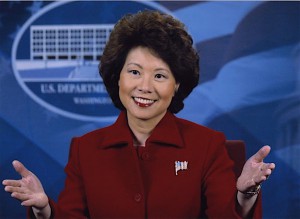
Transportation Secretary Elaine Chao said the new "guidance" for autonomous vehicle testing will help improve safety on U.S. roadways.
The Trump administration released its guidelines for testing and developing self-driving cars on U.S. highways and they were met with almost universal approval from automakers, industry observers and safety organizations.
Though federal legislation on the matter awaits approval by the U.S. Senate, the federal Department of Transportation and the National Highway Traffic Safety Administration’s updated “guidance,” as described by Transportation Secretary Elaine Chao, gives automakers and suppliers the green light to continue the development of automated system.
Chao said the updated parameters, dubbed “Automated Driving Systems – Vision 2.0,” build on the previous policy released by the Obama administration and incorporates feedback received through public comments and Congressional hearings.
“Automakers have been developing self-driving technologies for years, recognizing the tremendous potential for enhanced safety for us all and the greater self-sufficiency for certain populations,” according to a statement from the Alliance of Automobile Manufacturers.
(House passes bill easing autonomous vehicle testing restrictions. For the story, Click Here.)
“This federal guidance is helpful in advancing road safety and safe testing, while also providing more clarity on the role of states. The guidance provides the right balance, allowing emerging innovations to thrive while government still keeps a watchful eye over new developments.”
Though it may dovetail the previous administration’s efforts, it doesn’t necessary stick to them. There is a key area of difference. The new guidance alters an Obama-era policy that required automakers to submit an assessment showing their self-driving cars met certain safety criteria before they could place those vehicles on public roads.
Instead, the new DOT proposal suggests automakers “may” submit a voluntary safety self-assessment. This move allows companies to move along more rapidly in the development of this technology. Automakers already submit information to the government for other aspects of automotive development.
For example, they provide information from self-assessments on whether they meet current fuel economy standards, but face penalties if the figures are inaccurate or acquired by cheating as in the case of Volkswagen’s diesel-powered vehicles.
Chao said if self-driving cars fail to stand up to safety standards NHTSA will have the authority to order a recall. At least one group said it would be taking notes on just that provision.
“Today, with voluntary guidelines we look to the manufacturers who are driving automated technology forward to show leadership and accountability,” said Deborah Hersman, CEO of the National Safety Council, in a statement, adding, “(W)e will watch closely NHTSA’s commitment to utilize its recall authority to take vehicles off the road if there is any indication of a defect that places the public in harm’s way.”
(Click Here to see how CARB and the EPA were ready to face off in an emissions showdown.)
A Vision for Safety: 2.0 calls for industry, state and local governments, safety and mobility advocates and the public to lay the path for the deployment of automated vehicles and technologies, Chao said.
“In addition to safety, ADS technology offers important social benefits by improving access to transportation, independence and quality of life for those who cannot drive because of illness, advanced age or disability,” continued Secretary Chao.
Huei Peng, director of Mcity autonomous-vehicle test center run by the University of Michigan and the Roger L. McCarthy Professor of Mechanical Engineering at U-M, and Jim Sayer, director of the U-M Transportation Research Institute, agree the new policy is a positive step.
The trio notes that traffic deaths and injuries have been rising in recent years, and the adoption of automated vehicles and technologies will help save lives, cut fuel use and emissions, and bring mobility to those who cannot easily access transportation today. They added the new guidelines keep the United States at the front of autonomous vehicle development.
The new policy, however, does not roll back state regulations, which is something carmakers want as automated vehicle-technology continues to develop. The state of California, for one, is setting its own rules through the state Department of Motor Vehicles and is unlikely to yield to the Trump administration’s laissez-faire approach to regulating autonomous vehicles without a fight.
California’s role is critical because much of the research on automated vehicles is being carried out in the state. In addition, the Teamsters Union is pushing Congress to regulate self-driving trucks more tightly.
“This is what autonomous vehicle developers have been asking for,” said Rebecca Lindland, executive analyst at AutoTrader and Kelley Blue Book.
(To see more about environmental groups suing over easing of CAFE penalties, Click Here.)
“The DOT is clearly focused on safety, but at the same time, NHSTA’s guidelines should provide the flexibility developers want. Importantly, this set of regulations should help prevent a patchwork of state and federal standards, the type of competing regulations that can quickly strangle innovation.”


